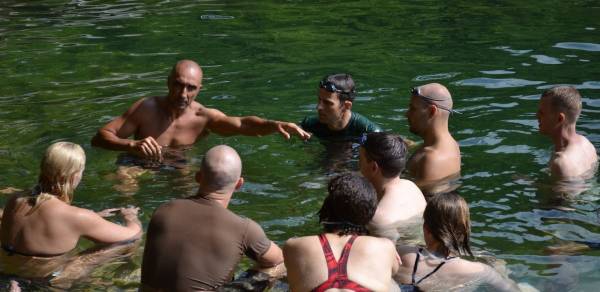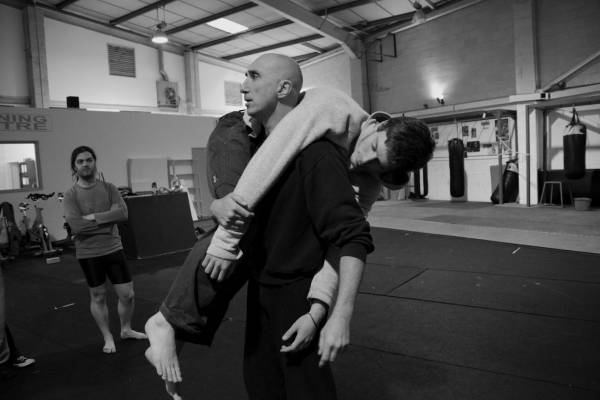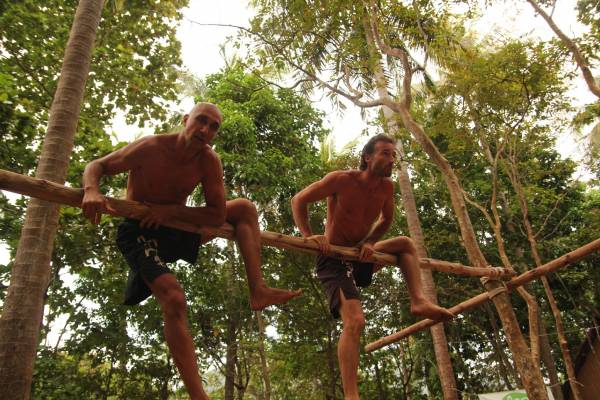Click Here to Start Vic’s Free 4-Week Program
If you feel as explosive as a sloth bear on phenobarbital, this article is for you. But even if you feel closer to a squirrel on a tree trunk, or if your nickname is “Flea” and you play bass for the Red Hot Chili Peppers, this article will give you some tips on how to use those fast twitch muscles that give you the feeling of an imminent brain seizure every time you drink a gallon of black coffee.
You’ve been training for a few months or a few years. Your strength is increasing and you have the feeling that your body is improving by the minute. Ideally, you’d like to look more like Dwayne “The Rock” Johnson than John Goodman. Only one fundamental question remains: “What can you do with this body of yours?” I strongly believe that the two most important qualities you can have when it comes to physical attributes are mobility and explosiveness.
Why Mobility?
Because if you cannot properly and safely move your limbs and your whole body in space, you’ll never be able to use the strength that you’ve progressively acquired through many hours of training. Mobility will help you to learn new movements, new sports, and new skills by allowing you to move gracefully and efficiently. Mobility is only remotely related to flexibility or stretching because mobility is dynamic movement. In other words, mobility is life.
Why Explosiveness?
Because many movements we do in sport and real life need to be or can be done very explosively. If you need to catch a bus or your toddler is relentlessly attracted to your swimming pool, explosiveness is the answer. You’re sparring with an opponent in the ring or fighting for your life against an aggressor: explosiveness is the solution to survive. Every time there is a sense of urgency, every time you need to generate power and speed (think acceleration rather than speed), there is an explosive component, and this explosive component doesn’t happen naturally for most of us. It has to be trained.
How to Train Explosiveness?
This is where it gets tricky. Most of the people I see are slow movers by nature. It’s not that they cannot be explosive if a bit of an adrenaline rush hits them in the face. It’s just that they don’t train this essential attribute, unless they train to be an MMA fighter, a track and field athlete, an Olympic lifter, or a football quarterback.
Simple exercises, methodology, and mindset should help you to go from a steady, slow pace to “all out” in a matter of weeks, not only when it comes to running, but to any movement in life and sport in general.
The program I have for you is based on the thirteen movement skills that MovNat qualifies as fundamentals of human movement: walking (yes, you can be explosive when walking!) balancing, running, jumping, crawling, climbing, throwing and catching, lifting and carrying, swimming, striking, and grappling.
For this program, I will leave aside the swimming part of it, as not everyone has easy access to a body of water at all times, but you’ll quickly understand how you can adapt the workouts to the aquatic environment if you want.

If you have a heavy bag or a very cooperative partner, you will be able to put some striking movements in as well. You need to be able to strike the object fast and hard. A big slam ball or yoga ball might work. A poster of Lady Gaga on a wall will not work.
Most of the exercises are simple by nature and you might already train them. They can be adapted to the equipment you have and are familiar with and with the place you usually train. You can do them in a gym setting, in a park, in your house, or at the zoo.
Running and Balancing
The obvious way to train your explosiveness is to sprint. A safe way to start that, especially if you haven’t sprinted in a while, is to sprint uphill. It will self-limit your sprint in order to avoid any injury. The goal is not to sprint until you throw up. The most important phase is the start, the beginning of the sprint. That’s where your intent will make the difference. Don’t sprint for more than twenty yards/meters and take as long as you want to recover.
You’ll see in the program that you’ll sprint from different starting positions (standing, seating, kneeling, etc). Each one of them will add more complexity and challenge to your training. With acceleration often comes the challenge of maintaining our balance. Some elements of the program will also incorporate a balancing component, especially when changing direction while running.
Lifting and Carrying
Again, the most important aspect is the intent. It doesn’t matter if you lift a dumbbell, a barbell, a kettlebell, a sandbag, a stone, or your five-year old son, as long as you do it with the right mindset: lifting it as fast, powerfully and explosively as you can. The object should literally fly up in the air from your hands. Obviously you don’t want the object to fly (especially your son), but that should be the mindset you have at the beginning of each lift.
You will find in the program different exercises, some of them coming from your daily life, some of them more technical, based on Olympic lifting, powerlifting, or gymnastics. At the beginning, I would recommend a sandbag, as I found it more forgiving technique-wise. Do whatever you feel comfortable doing, keeping good form and good technique while generating as much power and acceleration as you can. If your technique degrades, go lighter one notch, but don’t lower your explosiveness.

Walking and Crawling
There seems to be an endless list of crawling variations. On this program, I’ll focus on some basic crawling techniques that everyone knows (bear walk, crab walk, etc.), but feel free to incorporate other techniques you might know.
We’ll push some heavy and big objects (a car, a ball of hay, my mother, etc.), starting from a standing position and progressively lowering our position (tackle, kneeling, squatting, crawling, etc). Focus on the first two steps to be as explosive as possible, then reset your position while recovering for a few seconds before pushing again.
Throwing and Catching
You can use a slam ball, a medicine ball, a stone, a small log, or even a kettlebell if you feel like a daredevil. Ideally, you have a partner who will catch and throw the object back at you, but you can also do this by yourself and just throw the object as far as you can each time.
The throws will be at chest level, using your legs as the main source of power, your arms being mainly used to direct the object. The progression will also feature the swing throw (and catch) where the object is swung between your legs, relying more on the power generated by your hips (think kettlebell swing).

Jumping
Jumping can be considered the true king of explosiveness. In many institutions, young athletes’ vertical jumps are tested to detect those individuals who will be very explosive in their sport. As a matter of fact, there is no way to jump slowly.
In this program we’ll mainly jump in two directions: up and forward. You’ll do some box jumps (up) at different heights depending on your size and comfort level, and you’ll do some broad jumps (forward) onto targets that you draw on the floor. Focus on the power you generate (height or distance), but don’t compromise your landing technique. Being explosive doesn’t mean landing like a wrecking ball in a scrapyard. Make sure you land according to the three Ss: safely, softly, and silently.
Climbing
Climbing can and sometimes must be explosive as well. I’m not talking about a long stretch of rock that you take twenty minutes to climb. I’m talking about quickly climbing a wall or a fence while being chased by an angry and hungry pitbull. If you observe a cat climbing a tree, they usually run and get some momentum, or simply squat and jump as high as they can and use this momentum to climb up the tree, discovering in the process that they’re too scared to go down on their own. A muscle up is a good example of explosive climbing for humans. With a lot of training it’s possible to do it slowly, but first it has to be explosive.
The main movements in this program will be pull ups, chin ups, and dips. They might not be the best climbing movements in my opinion, but everyone knows them and you can really be explosive if you want. You can also be weighted (dip-belt, weighted vest, kettlebell between your teeth), vary the grip (pronated, supinated, alternate, one hand, etc). You can even swap out for some muscle ups if you’re already comfortable doing them.

Methodology
If you decide to take on this goal of becoming more explosive, then you will have to switch to a different training protocol during these weeks – because we only train three times per week. Why only three times? Because we train the nervous system to recruit as many muscle fibers as possible as fast as possible and that’s very taxing.
These sessions don’t take much time because they must be short and intensive (near 100% of your maximum muscular contraction). Take enough rest between each exercise or get a cocktail and do something else at a slow pace. When manipulating objects, start with a moderate load first. The intent is to create rapid acceleration, not to lift your personal record.
Give It a Try
This program is purely empirical, based on real life experience and common sense. Give it a try and see how explosive you are and you become. Remember that Jim the Gentle Giant may be big and impressive, but he can’t move his body mass quickly when needs arise, and it’s Mean Mike who manages to sprint, jump, and climb the fence to save the kid, get the girl and walk off into the sunset.






